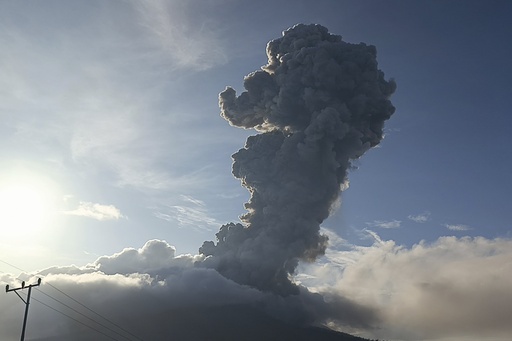
MAUMERE, Indonesia — Mount Lewotobi Laki Laki erupted once more on Thursday, emitting a significant plume of heated clouds that reached an altitude of 2,500 meters (8,200 feet) from the summit. This took place just three days after a midnight eruption resulted in the deaths of nine individuals and left numerous others injured.
Currently, there are no immediate reports of injuries or fatalities linked to the most recent eruption. The 1,584-meter (5,197-foot) volcano located on the isolated island of Flores released clouds of gray hot ash, as confirmed by Indonesia’s Center for Volcanology and Disaster Mitigation. The volcanic activity propelled a combination of rock, lava, and gas up to 1 kilometer (0.6 mile) from the crater.
Following the deadly eruption on Monday, which tragically killed nine people and injured approximately 64, the volcano had shown a decrease in eruptive activity. The eruption on Monday impacted more than 10,000 residents across 10 villages, leading to the evacuation of around 4,400 individuals who sought refuge in temporary emergency shelters. The eruption resulted in destruction to seven schools, nearly two dozen homes, and a convent on the predominantly Catholic island.
In light of the ongoing volatility, Indonesia’s volcano monitoring agency raised the alert status for Lewotobi Laki Laki to the highest level and expanded the exclusion area to a radius of 7 kilometers (4.3 miles), thereby prohibiting any activity within that zone.
Officials have cautioned the thousands of evacuees against returning home, as plans are in place to relocate about 16,000 residents from the perilous area, according to Suharyanto, the head of the National Disaster Management Agency. “Long-term relocation is seen as a crucial mitigation strategy to prepare for future eruptions,” Suharyanto shared with reporters during his visit to the affected regions on Thursday.
Lewotobi Laki Laki is part of a duo of stratovolcanoes in East Flores district located in the East Nusa Tenggara province, often referred to as the husband-and-wife mountains by locals. The term “Laki laki” translates to “man” while its counterpart, Lewotobi Perempuan, means “woman.”
Earlier this year in January, approximately 6,500 people were evacuated due to heightened activity from Mount Lewotobi Laki Laki, which expelled thick clouds of ash, prompting the closure of Fransiskus Xaverius Seda Airport on the island. Although there were no reported casualties or substantial damage from that eruption, the airport remains shut down due to ongoing seismic threats.
On October 27, another volcanic event occurred at Mount Marapi in West Sumatra, one of Indonesia’s most frequently active volcanoes. This eruption sent thick ash clouds into the atmosphere at least three times, blanketing nearby communities in debris, but similarly did not result in casualties.
Lewotobi Laki Laki is among 120 active volcanoes in Indonesia, which is home to 280 million residents. The nation is susceptible to earthquakes, landslides, and volcanic eruptions due to its location along the “Ring of Fire,” a series of seismic fault lines encircling the Pacific Ocean.
